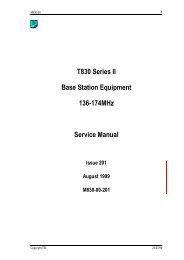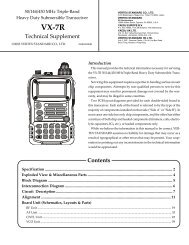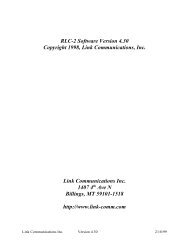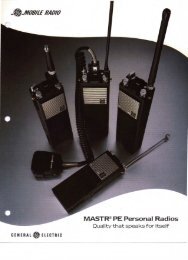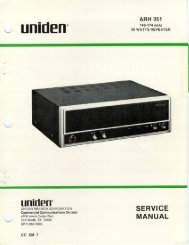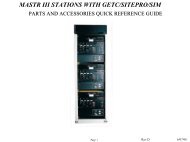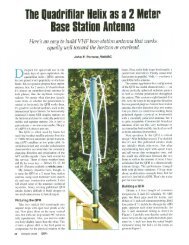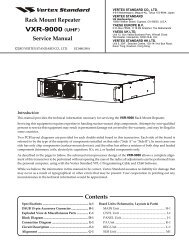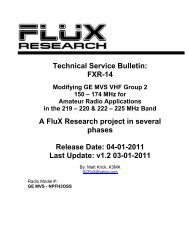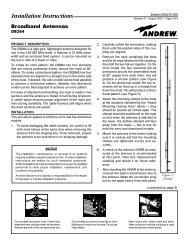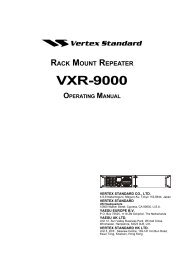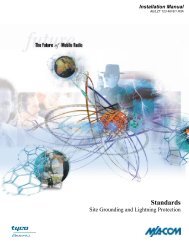HAMTRONICS® LNP-( ) RECEIVER PRESELECTOR ...
HAMTRONICS® LNP-( ) RECEIVER PRESELECTOR ...
HAMTRONICS® LNP-( ) RECEIVER PRESELECTOR ...
You also want an ePaper? Increase the reach of your titles
YUMPU automatically turns print PDFs into web optimized ePapers that Google loves.
HAMTRONICS® <strong>LNP</strong>-( ) <strong>RECEIVER</strong> <strong>PRESELECTOR</strong>: INSTALLATION,<br />
OPERATION, & MAINTENANCE<br />
DESCRIPTION.<br />
The <strong>LNP</strong>-( ) series of preselectors is<br />
designed to reduce out of band interference<br />
in vhf receivers from broadcast<br />
and paging transmitters and<br />
other strong signals in nearby bands.<br />
It consists of a low-noise preamp driving<br />
a sharp, three stage L-C filter.<br />
The preamp stage has just enough<br />
gain to prevent degradation of noise<br />
figure due to the insertion loss of the<br />
filter and provides a minimal amount<br />
of net gain to avoid overloading the<br />
receiver.<br />
The low-noise preamp stage employs<br />
one of the new generation diodeprotected<br />
dual-gate MOS FET devices<br />
which are designed exclusively for use<br />
in the vhf & uhf bands. Surface<br />
mount technology is used in the preamp<br />
stage to obtain minimum noise<br />
figure and best stability.<br />
The <strong>LNP</strong> Preselector is connected<br />
in series between the antenna and the<br />
receiver. They were designed for operation<br />
in 50 ohm systems; however,<br />
they will operate satisfactorily on 75<br />
ohms as well.<br />
INSTALLATION.<br />
MOUNTING. The preselector can<br />
be mounted to any flat surface with<br />
standoffs and 4-40 screws through<br />
the two mounting holes. The ideal<br />
location is in the chassis with the receiver.<br />
Complete shielding of the preselector<br />
is not required. However, some<br />
care should be given to selection of<br />
the mounting location with regard to<br />
feedback from adjacent receiver circuits<br />
or rf pickup if mounted very<br />
close to a transmitter circuit. Because<br />
the unit is small, make sure that it<br />
isn't installed tight against the rf amplifier<br />
or first mixer of the receiver to<br />
minimize feedback effects.<br />
For best results, in a receiving system<br />
when antenna is not also used for<br />
transmit, preselector can be mounted<br />
right at the antenna. Install the preselector<br />
in a project box and mount<br />
the box on a flat aluminum panel U-<br />
bolted to the antenna mast. Then,<br />
caulk around base of preselector and<br />
around B+ and coax connectors to<br />
weatherproof unit. Silicone sealant is<br />
good for this purpose.<br />
RF CONNECTIONS. Antenna and<br />
receiver connections are made with rf<br />
type RCA plugs to the input and output<br />
jacks on the preselector. The RF<br />
INPUT must be connected to the antenna,<br />
and the RF OUTPUT must be<br />
connected to the receiver input.<br />
Use good quality low-loss coax to<br />
maintain low noise operation. Remember<br />
that any loss in coax from<br />
antenna cannot be made up later in<br />
the preselector; it adds directly to system<br />
noise figure.<br />
Note that special rf type RCA plugs<br />
with good cable clamps are available<br />
from us (model A5) as an accessory.<br />
It is very important to use the proper<br />
plugs and make sure the coax pigtails<br />
soldered to the plugs are as short as<br />
possible. Attempts to use a different<br />
type of connector or to solder coax<br />
directly to the board should be<br />
avoided because it would degrade performance.<br />
CAUTION: The preselector cannot<br />
be used on a transceiver unless you<br />
have a way to connect it only in the<br />
receive rf path.<br />
POWER CONNECTIONS. Power<br />
for the unit must be filtered +10 to 15<br />
Vdc. Current drain is about 10 mA.<br />
Solder positive supply wire to solder<br />
pad E1 on the board. Many times,<br />
the power supply ground connection<br />
can be made through the coax shield.<br />
Otherwise, connect a separate power<br />
supply ground wire to the ground<br />
plane on the pc board.<br />
If you have a receiver which feeds<br />
+12Vdc up the antenna cable to a<br />
preselector, rf choke L5 can be added<br />
to the <strong>LNP</strong>-( ) Preselector to allow<br />
power to be taken from the coax.<br />
(This choke is not supplied.) Note that<br />
such an arrangement can affect the rf<br />
performance of a preselector; so we<br />
recommend you use a separate piece<br />
of hookup wire to provide power<br />
whenever possible.<br />
CAUTION: Solid state amplifiers<br />
can be damaged by large voltage transients<br />
and reverse polarity. Although<br />
protection is provided in the preselector,<br />
avoid such conditions as a matter<br />
of principle. Special care should be<br />
taken to install reverse transient absorbing<br />
diodes across any inductive<br />
devices, such as relays. If the preselector<br />
is connected to an antenna<br />
used for transmit as well as receive,<br />
be sure that the unit is connected<br />
only in the receive path and that the<br />
coax relay has sufficient isolation to<br />
avoid coupling large amounts of rf to<br />
the preselector.<br />
OPERATION.<br />
The <strong>LNP</strong> series preselectors operate<br />
in linear mode; so they may be used<br />
to receive any mode of transmission,<br />
including ssb and atv.<br />
They are factory aligned at the center<br />
of the band, and they are easily<br />
readjusted if your operating frequency<br />
is near one end of the band or the<br />
other instead of being near the center.<br />
If retuning is necessary, simply retune<br />
the variable capacitors and coils for<br />
best reception of weak signals. No<br />
test equipment is necessary. If you<br />
happen to have access to a signal<br />
generator and sinadder, they may be<br />
used; otherwise, just do it by ear or S-<br />
meter.<br />
Low-noise preamps are effective in<br />
improving sensitivity of receivers in<br />
weak signal areas. However, it is<br />
normally considered inadvisable to<br />
use a preamp, even with a well designed<br />
receiver, in very strong signal<br />
MODEL TUNES RANGE<br />
TYPICAL<br />
NOISE FIG.<br />
NOM.<br />
GAIN<br />
TYP. 3DB<br />
BANDWIDTH<br />
TYP. 20DB<br />
BANDWIDTH<br />
TYP. 30DB<br />
BANDWIDTH<br />
TYP. 40DB<br />
BANDWIDTH<br />
<strong>LNP</strong>-137 132-144 MHz 0.6 dB 18 dB ±1 MHz ±3.5 MHz ±4.6 MHz ±7 MHz<br />
<strong>LNP</strong>-146 140-155 MHz 0.6 dB 18 dB ±1 MHz ±3.8 MHz ±4.8 MHz ±7 MHz<br />
<strong>LNP</strong>-160 150-170 MHz 0.6 dB 16 dB ±1 MHz ±4 MHz ±5 MHz ±7.5 MHz<br />
<strong>LNP</strong>-220 216-230 MHz 0.6 dB 10 dB ±2 MHz ±8 MHz ±13 MHz ±18 MHz<br />
Note: Unless otherwise requested, units are factory aligned to the nominal frequency of 137, 146, 160, or 223 MHz.<br />
©1999 Hamtronics, Inc.; Hilton NY; USA. All rights reserved. Hamtronics is a registered trademark. Revised: 12/12/02 - Page 1 -
areas, such as the center of a large<br />
city or other locations with high powered<br />
transmitters on all sorts of frequencies.<br />
Adding gain ahead of a receiver<br />
degrades the selectivity of a receiver<br />
by an equivalent amount by boosting<br />
undesirable signals as well as desirable<br />
ones. In severe cases, strong<br />
signals which do not cause intermod<br />
by themselves will create intermod in<br />
the rf stage or mixer of your receiver<br />
after being amplified an additional<br />
amount by the preselector.<br />
If you use a preselector with a repeater<br />
receiver, you will need to have<br />
additional rejection in your duplexer<br />
to attenuate your transmit signal that<br />
much more to prevent desense.<br />
TROUBLESHOOTING.<br />
Since the unit is fairly simple,<br />
troubleshooting usually is limited to<br />
checking the dc voltages on the transistor.<br />
These will vary somewhat; but,<br />
in general, the source voltage should<br />
be 0Vdc, gate-2 should be about 3.5<br />
to 4Vdc, and the drain should be<br />
Parts List, Parts which change with Frequency Band.<br />
Model L1 C5 C6 C7 C8 C9 C10<br />
<strong>LNP</strong>-137 5T #20 bus on ¼-20 screw form 18 pf 0.5 pf 20 pf 0.5 pf 27 pf 82 pf<br />
<strong>LNP</strong>-146 5T #20 bus on ¼-20 screw form 15 pf 0.5 pf 18 pf 0.5 pf 22 pf 62 pf<br />
<strong>LNP</strong>-160 4T #20 bus on ¼-20 screw form 12 pf 0.5 pf 15 pf 0.5 pf 18 pf 56 pf<br />
<strong>LNP</strong>-220 5T #20 bus on 8-18 screw form 5 pf n/u 7 pf 0.5 pf 10 pf 27 pf<br />
8Vdc. Current drain should be no<br />
more than 20 mA (10mA typical).<br />
The two common failure modes,<br />
caused by excessive rf or dc voltage<br />
transients, may cause the gate-2 voltage<br />
to be quite low or the same as the<br />
drain of the transistor, indicating an<br />
internal short. Generally, dc power<br />
line problems, such as transients<br />
cause a drain to gate-2 short and high<br />
rf fields or lightning coming in the<br />
antenna connector usually cause a<br />
gate-1 to source short. The latter<br />
usually doesn’t show up as a change<br />
in dc voltage because gate-1 is connected<br />
to dc ground in the circuit. A<br />
sudden loss of sensitivity with no<br />
change in dc voltage usually indicates<br />
damage to the input gate (gate-1).<br />
Note that the two gates have built-in<br />
diode protection, but diodes will only<br />
withstand a limited surge; beyond<br />
that, the diodes will be damaged along<br />
with the FET.<br />
CAUTION: FET's are static sensitive.<br />
If replacement is necessary, be<br />
sure to ground your wrist before handling<br />
them. Internal diode protection<br />
will reduce, but not eliminate, risk.<br />
Devices also are heat sensitive; so<br />
don't apply soldering iron longer than<br />
necessary. If FET is replaced, be sure<br />
to orient as shown with the source<br />
lead being the wide one.<br />
Often times, the best way to remove<br />
surface mount devices from a<br />
board are to cut the part up, removing<br />
the leads individually and then unsoldering<br />
them.<br />
PARTS LIST, COMMON<br />
PARTS FOR ALL MODELS.<br />
Ref # Value (marking)<br />
C1 4.5pf variable cap.<br />
C2 11pf variable cap.<br />
C3, C4 .001 µf chip cap.<br />
C11,C12 .001 µf chip cap.<br />
D1 1N4148 diode<br />
J1,J2 RCA jack (rf type)<br />
L2 – L4 2½ turn slug-tuned coil<br />
L5 (option) 0.33µH rf choke<br />
Q1 Philips BF-998 MES FET<br />
R1 620Ω chip resistor<br />
R2, R3 86K chip resistor<br />
R4 47Ω chip resistor<br />
R5 not used<br />
U1 78L08ACD voltage regul.<br />
Figure 1. <strong>LNP</strong>-( ) Preselector, Parts Location and Schematic Diagrams<br />
©1999 Hamtronics, Inc.; Hilton NY; USA. All rights reserved. Hamtronics is a registered trademark. Revised: 12/12/02 - Page 2 -



